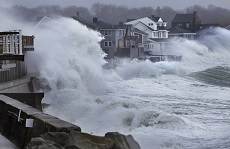 In the post Scoping long-term sea level rise I indicated the possibility of 25 metres (±5) of SLR with emissions of 380 (360-400)ppm and a temperature variance of 2.7 to 3.7°C. The question was really how long it would take, and what were the prospects for the next century or three.
In the post Scoping long-term sea level rise I indicated the possibility of 25 metres (±5) of SLR with emissions of 380 (360-400)ppm and a temperature variance of 2.7 to 3.7°C. The question was really how long it would take, and what were the prospects for the next century or three.
The received wisdom seemed to be that we could expect about a metre, by 2100, and some studies limited SLR to about two metres in the next millennium. A new study suggests we could get close to two meters in total by 2100. Moreover the melting of ice on Antarctica alone could cause seas to rise more than 15 meters by 2500.
The study by Robert M. DeConto and David Pollard was reported in The Washington Post. (See also Climate Central.) They used
- a model coupling ice sheet and climate dynamics—including previously underappreciated processes linking atmospheric warming with hydrofracturing of buttressing ice shelves and structural collapse of marine-terminating ice cliffs—that is calibrated against Pliocene and Last Interglacial sea-level estimates and applied to future greenhouse gas emission scenarios.
In short they constructed a model that took into account the paleorecord of ice sheet decay.
They believe that recovery following a hypothetical draw-down of CO2 would not be quick, because the ocean would need to cool before the ice rebuilds. High sea levels could be with us for millennia.
Without doubt other scientists will work on the problem, which will be informed by studies of current and past melting, providing concrete observations in specific locations.
One such is the Totten Glacier in East Antarctica, where Australian researchers have a special interest because of the location of the Casey Station. A team of 100 researchers will be down there this summer. They will be using all manner of instrumentation to measure glacier speed, levels, ponding and echo-sounding gear to work out what’s happening at the base of the ice sheet.
This image from the ABC story shows the location of the Totten basin:
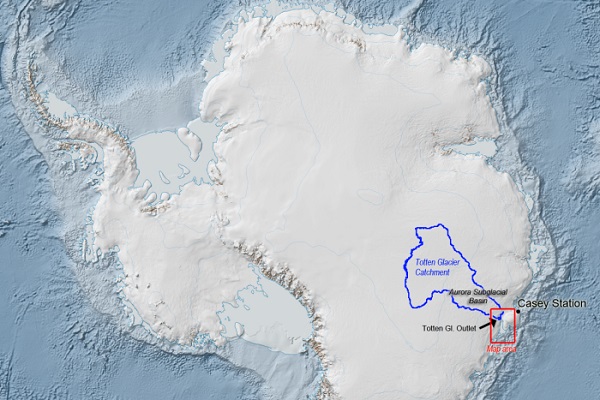
Alan Aitken, who was lead author of a recent paper studying the historic retreat and advance of the glacier, explains:
- The observed patterns suggest that the ice sheet has spent much of its history in one of two configurations: either the edge has been close to the current Antarctic coast (within 150 kilometres); or it has been located some 350-550 kilometres inland. In either of these states, the ice would be relatively stable, with this glacier providing sea level fluctuations of less than a metre over the course of glacial cycles.
Problem is that we are pushing the climate harder and faster than what happened in the “course of glacial cycles”. The next retreat pattern would yield over two metres.
This image from the New Scientist shows where the sea could intrude under the ice, as well as narrow seeways that may open up across West Antarctica:
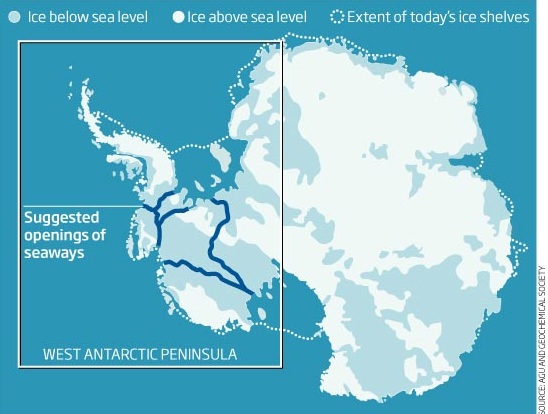
Totten is one of the more stable of the areas expected to melt, but provides about 15% of Antarctica’s total melting when it comes into play.
Elsewhere researchers have found that Greenland rises as the ice sheet melts faster. In what is called glacial isostatic adjustment, the bedrock in southeast Greenland is rising about 12mm per year.
- These rates are due to low upper mantle viscosity in the region, from when Greenland passed over the Iceland hot spot about 40 million years ago.
As a consequence the earth’s crust is thinner in this region which has been responsible for 77% of the total ice loss between 1900 and 1980. The researchers also found that ice loss of the whole of Greenland had been underestimated by about 20 gigatons per year. I think that’s about 10%.
Another line of research had found that Greenland is getting darker, and hence absorbing more heat from the sun. Partly it’s soot from wildfires and such, but:
- In the summer, the surface ice starts to melt. As the top layers trickle away, old impurities are exposed, darkening the surface and making it more sun-receptive. As the snow freezes again, the grains of snow get bigger – as water becomes ice, it makes a glue for the snow grains – and the bigger grains make a less reflective surface.
Further data from observations around the world will feed into the models. My expectation is that the next IPCC report will equivocate less about sea level rise. Planning authorities will need to respond.
Cities are currently slow to take on board planning for sea level rise:
- Of 533 cities, 89% recognise climate change as a significant risk, according to a recent report. But just 210 of 490 surveyed cities report an active climate adaptation plan.
The Washington Post has articles here and here on the DeConto and Pollard research and has maps of cities showing where homes could be in danger. This should help to concentrate the mind.
Many of the most vulnerable cities are in Asia. I’ll repeat here a map of vulnerable Asian cities, from a 2009 UNEP report:
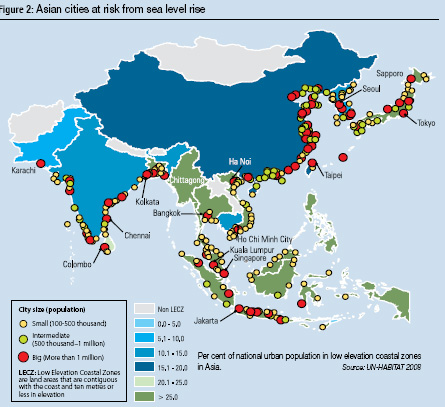
Each red dot is a city with a million or more people.
In the US, apart from Miami and new Orleans, Boston and New York will become especially vulnerable, because water piled up against Greenland through the gravitational effect will flow away. Here’s how it works, from the New Scientist:
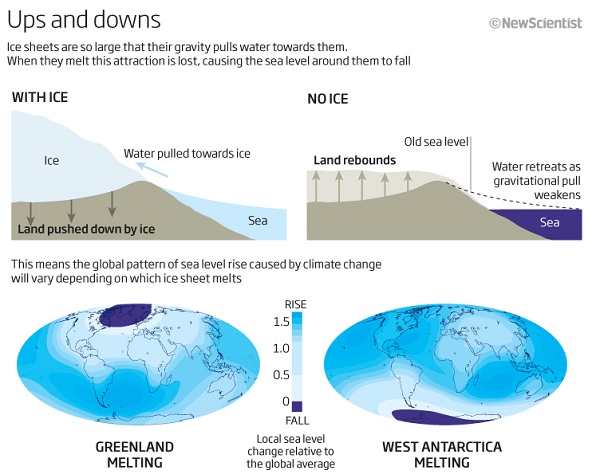
Also Hurricane Sandy-sized floods will be up to 17 times more likely by 2100.
Here’s what happened in North Carolina during Hurricane Irene in 2011:
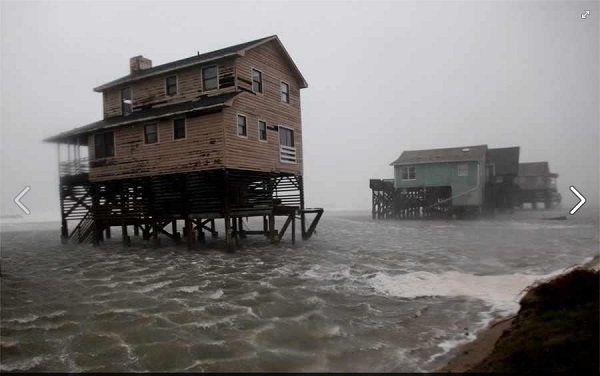
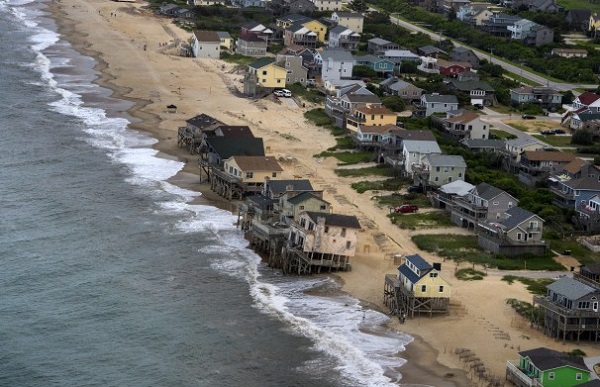
Sea level rise has been controversial in North Carolina. They appear to be thinking now in terms of a metre. This is what the map looks like in the Albemarle-Pamlico Estuarine system:
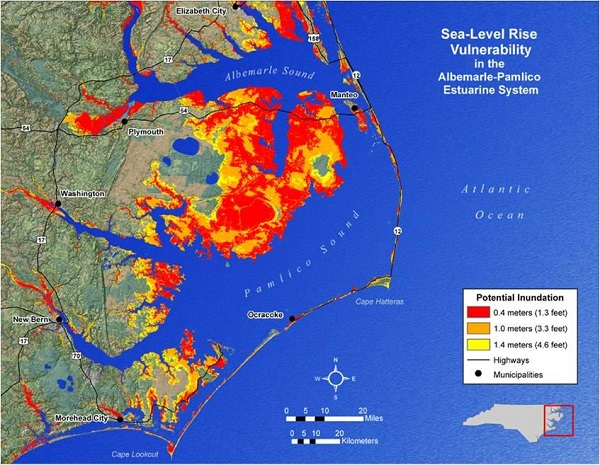
Time to get the head out of the sand:
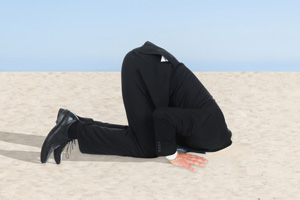

A sensible country might come up with plans that will reduce the impact of sea level rise by doing things like limiting new developments to higher ground.
One of the problems is the resistance of those who see the introduction of these rules having a large impact of property values within the affected area.